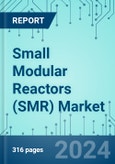By 2050, the Small Modular Reactor (SMR) Market is Anticipated to Achieve an Annual Value of $3.9 Trillion
Small Modular Reactors (SMRs) present an alluring prospect in the field of nuclear energy by offering the potential for reusing spent nuclear fuel. This process not only contributes to sustainability but also enhances the efficiency of nuclear waste management. Recycling waste fuel not only minimizes waste volume but also reduces the demand for raw materials, presenting economic and environmental advantages.
One notable innovation in SMR technology is the Fully Ceramic Micro-encapsulated (FCM) fuel, which ensures inherent reactor safety through a robust design. TRISO particles, containing radioactive byproducts within layered ceramic coatings, are encased within a silicon carbide matrix, providing exceptional stability even under high temperatures. This technology, refined over six decades of development, offers reliability and safety in nuclear fuel systems.
The growing capacity of renewable energy projects waiting for interconnection surpasses current power plant capacities, posing challenges due to intermittency issues. SMRs emerge as a viable solution to this problem, offering continuous, noncarbonized energy generation. Notably, sodium-cooled fast SMR reactors, operational in Russia, contribute dense, noncarbonized energy to the grid.
In the United States, TerraPower, led by Bill Gates, partners with GE Hitachi to develop sodium-cooled fast reactor SMR solutions, incorporating molten salt energy storage. The Natrium project represents a milestone in providing clean, flexible energy with integrated energy storage, enhancing grid stability. Leveraging decades of expertise, this collaboration aims to revolutionize nuclear energy technology.
SMRs present a compelling alternative to traditional coal, gas, and fossil fuel-based energy generation. Proven technology, as evidenced by their successful deployment in various sectors, coupled with anticipated cost reductions through mass production, underscores their potential to replace outdated energy infrastructure. The upcoming construction of a land-based SMR microreactor by BWXT underscores the commitment to advancing nuclear technology for environmental sustainability and energy security.
In conclusion, SMRs represent a transformative force in the energy landscape, offering a combination of reliability, sustainability, and scalability. As efforts intensify to mitigate climate change and transition towards cleaner energy sources, SMRs stand poised to play a pivotal role in shaping the future of global energy generation.
Table of Contents
- Overview
- SMRs Provide Significant Energy Density
- SMR Solves Energy Needs
- Advanced Nuclear Technologies are Used to Achieve Decarbonization
- Customers Achieve Meet Decarbonization Goals, Reduce Construction Costs
- Renewable Energy Needs SMR Energy Dense Solution for Grid Interconnection
- Grid Interconnection Queues Grew 49% Year-Over-Year in 2023
- 1,350 GW of Renewable Generation and 680 GW of Storage Waiting for Approval
- Typical Renewable Project Spent Five Years in Queue for Interconnection Approval
- SMR Nuclear Reactors Bypass this Difficulty as They Replace Existing Coal Plants
Companies Mentioned (Partial List)
A selection of companies mentioned in this report includes, but is not limited to:
- BWXT
- GE Hitachi
- TerraPower








